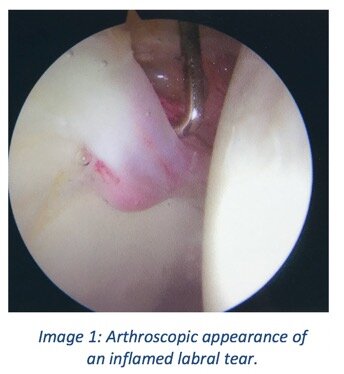Femoroacetabular Impingement (FAI) and Hip Arthroscopy
By Patrick S. Buckley, MD
Femoroacetabular impingement, also known as “FAI”, is a common cause of hip pain in athletes and young adults. FAI is a condition that develops when there is abnormal contact between the “ball” (femoral head) and “socket” (acetabulum) during normal hip motion. Combined with repetitive activities of hip flexion required for many sports and day-to-day life, this condition can lead to a torn labrum, cartilage damage, and hip/groin pain.
Hip pain from FAI often manifests as groin pain, and may also cause mechanical symptoms such as locking or catching in the hip. FAI is often exacerbated by high flexion activities and can alter bony mechanics of the hip and cause muscle imbalances. Overtime, this repeated conflict between the acetabulum and the femoral neck can lead to arthritis.
A thorough hip exam in the office often shows loss of motion of the hip, especially in flexion and internal rotation. X-rays can be performed in the office to evaluate the bony anatomy of the hip. Special views may show a “bump” on the femoral head/neck junction (CAM deformity), a socket that is too deep (pincer impingement) or too shallow (dysplasia).
Non-operative treatment for FAI often involves anti-inflammatory medications, physical therapy, and injections into the hip joint. The goal with physical therapy is to correct posterior muscle weakness, strengthen lower back and pelvic floor muscles, and improve pelvic tilt. Injections into the hip such as lidocaine or cortisone can help reduce pain, but also provide a diagnostic benefit to confirm the location and etiology of the pain.
If these treatments do not resolve the symptoms for the patient, then a minimally invasive surgery called a hip arthroscopy can be considered. Hip arthroscopy is a procedure where a camera and instruments are inserted through small, 1-2-inch incisions to visualize and correct the abnormal areas of contact of the hip joint. With this technique, I can address labral tears, cartilage damage and reshape the bony areas that are causing impingement. Combined with post-operative physical therapy, this treatment is been highly effective to improve pain and return patients back to their active lifestyle.
Pictured below are images showing the before and after of FAI correction in a 21-year-old hockey player who successfully returned to sport after resolution of his hip and groin pain with hip arthroscopy.





